|
Back
to Children's Corner
Ireland's
Seashore
Photography
by Paul Kay & Terry Farnell
©
Sherkin
Island Marine Station
|
|
Scorpion
Spider Crab
Inachus dorsettensis
Portán faoilinne scairpe
There
are several species of spider crab to be found on the shore.
All get their name from their long-legged, spidery appearance,
although, unlike spiders, they have five pairs of walking
legs, including the pincers. All spider crabs have a roughly
triangular body. In the Scorpion Spider Crab, this may be
heavily camouflaged with sponges and seaweed, which it has
picked off the rock and stuck to its shell. It has a curious
habit of holding its pincers poised close to its body.
|
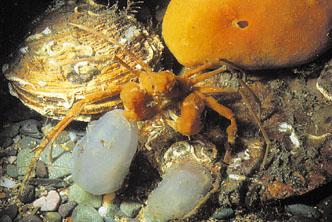
|
|
|
|
Blue-rayed
Limpet
Helcion pellucidum
Bairneach mín
Often
found attached to the fronds of kelp seaweeds, this sea snailís
body is covered by a single uncoiled shell. When young, the
shell is smooth and orange-brown in colour with broken electric
blue lines running down its length. With age, its colour fades
to a dull brown, with darker banding and grey lines. The Blue-rayed
Limpet normally feeds on kelps, but also feeds on encrusting
animals or plants. Oval scars on the fronds and stems of kelps
are "home bases" to which the limpet returns after feeding.
|
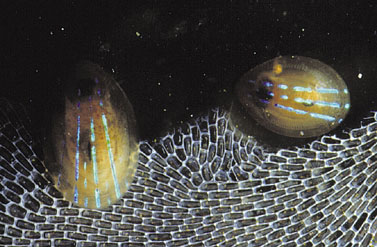 |
|
|
|
Dahlia
Anemone
Urticina felina
Bundún leice dáilia
This is
the largest anemone to be found on the shore. It gets its
name from its stunning, flower-like appearance. The short,
stubby tentacles and mouth disc are patterned with bands of
colour ranging from blues and greens to pinks and reds. A
strong, sucker-like base ensures firm attachment to the rock,
even in the most wave-swept sites. The column is often covered
with warts to which bits of shell and gravel stick, providing
a good disguise when the tentacles are drawn inside.
|
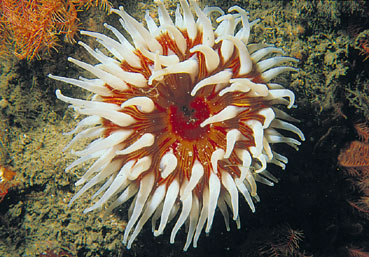 |
|
|
|
Mermaid's
Purse
Scyliorhinus canicula
Sparán na caillí mairbhe
The Mermaidís
Purse is the egg case laid by the dogfish in deeper waters.
It has long, twisted tendrils on each corner which are used
to attach the egg case to seaweed and other floating structures.
It is light brown and almost see-through. The egg case is
usually only seen when it is washed up on the shore, and then
it is often dry and hard. It is normally empty, as the young
fish will have hatched by the time the case is washed ashore.
|
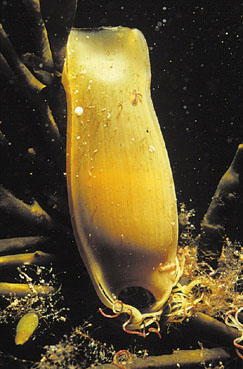 |
|
|
|
Breadcrumb
Sponge
Halichondria panicea
Spúinse grabhrógach
One of
the commonest sponges to be found on the seashore, the Breadcrumb
Sponge, forms encrusting patches on rocks and on the stems
of kelp. Varying in colour from yellow to pale green, it has
a distinctive appearance. The smooth surface is dotted with
volcano-shaped openings which are called exhalent openings.
The inhalent openings are too small to see. When handled,
the crumbly-textured sponge breaks easily and gives out a
strong bread-like smell, hence its common name.
|
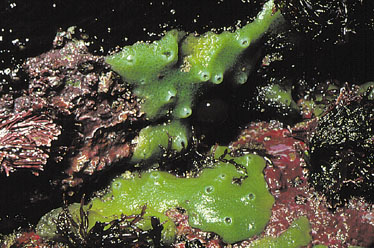 |
|
|
|
Velvet
Swimming Crab
Necora puber
Luaineachán
This crab
gets its name from the velvet feel of its shell, and its paddle-like
back legs, which are used for swimming. Its bright, red eyes
and aggressive nature have earned it the nickname "red-eyed
devil". The hairy carapace is wider at the front than at the
back. The front edge is also deeply toothed, giving it a saw-like
appearance. Usually dark grey to brown in colour, features
to look out for are the dark blue-black lines on its legs
and bright blue joints.
|
 |
|